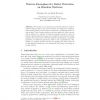Free Online Productivity Tools
i2Speak
i2Symbol
i2OCR
iTex2Img
iWeb2Print
iWeb2Shot
i2Type
iPdf2Split
iPdf2Merge
i2Bopomofo
i2Arabic
i2Style
i2Image
i2PDF
iLatex2Rtf
Sci2ools
ICAPR
2005
Springer
2005
Springer
Texture Exemplars for Defect Detection on Random Textures
We present a new approach to detecting defects in random textures which requires only very few defect free samples for unsupervised training. Each product image is divided into overlapping patches of various sizes. Then, density mixture models are applied to reduce groupings of patches to a number of textural exemplars, referred to here as texems, characterising the means and covariances of whole sets of image patches. The texems can be viewed as implicit representations of textural primitives. A multiscale approach is used to save computational costs. Finally, we perform novelty detection by applying the lower bound of normal samples likelihoods on the multiscale defect map of an image to localise defects.
| Added | 27 Jun 2010 |
| Updated | 27 Jun 2010 |
| Type | Conference |
| Year | 2005 |
| Where | ICAPR |
| Authors | Xianghua Xie, Majid Mirmehdi |
Comments (0)

